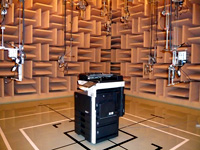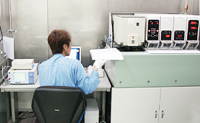Customer Satisfaction and Product Safety
Achieving Top-Tier Quality and Reliability
Click to jump to the corresponding section in this page
Konica Minolta's Approach
Background and Issues
Ensuring product and service safety and security is essential for delivering consistently high quality. It goes without saying that Konica Minolta strives to improve the quality of and ensure the safety of the hardware it provides. With the advancement of IoT, Konica Minolta also recognizes that a more robust approach to IT threats is crucial to sustainable growth, as they can cause serious damage to customer operations.
Vision
To deliver value to customers, Konica Minolta continually seeks to enhance its products and services, incorporating cutting-edge technologies. Simultaneously, the Group is raising awareness among employees about addressing quality from the customer's perspective, while continuously enhancing quality management activities. The aim is to provide customers with products and services that offer even greater convenience, safety and peace of mind.
Key Measures and KPIs
| KPI | Results | Targets | |||||
|---|---|---|---|---|---|---|---|
| FY2020 | FY2021 | FY2022 | FY2023 | FY2024 | FY2024 | FY2025 | |
| Number of serious product-related accidents* | 0 | 0 | 0 | 0 | 0 | 0 | 0 |
- *
- Serious product-related accidents refer to those accidents that cause serious harm to the product user's life and/or body and accidents that cause serious damage to assets other than the product.
- *
- Scope of aggregation: All Konica Minolta products
See Social Data (Excel) in ESG Data page for the results of previous years
Improving the Quality Assurance System
Taking various steps to improve the quality assurance system
Konica Minolta has established a quality assurance system. It is striving to improve its ability to resolve market quality problems that are related to the safety of products and services and is working to avoid serious accidents and reduce quality problems.
Investigating Quality Problems via Regular Meetings
Konica Minolta regularly holds quality meetings across the Group to discuss product safety and other quality-related issues and work to continuously improve quality by thoroughly implementing the PDCA cycle.
Addressing Market Quality Issues
Whenever a problem related to product and service quality occurs, sales sites around the world are required to register information in a Group-wide critical accident report database immediately. Registered information is instantly sent to the appropriate supervisor and shared with relevant departments. Using this system, the Group takes action to prevent a recurrence by thoroughly investigating all registered incidents, analyzing the causes, implementing countermeasures, and reflecting these in technical and assessment standards. In the unlikely event of a safety-related incident, a report will be immediately filed with the supervisor of the individual business and shared with the Chief Quality Officer, as well as with the departments in charge of quality assurance, corporate communications, and legal affairs, regardless of the cause of the problem. When a quality problem with a potentially serious risk arises, a Quality Problem Countermeasure Conference is convened based on the Group Market Quality Management Rules in order to promptly deal with the issue and ensure thorough information disclosure.
Strengthening Quality Fraud Prevention Activities
With the recent rash of quality fraud cases at other companies, one of Konica Minolta's top priorities is to strengthen and expand its prevention efforts. To minimize the risk of quality fraud cases, in addition to conducting periodic diagnoses and audits based on the Quality Fraud Prevention Guidelines, which cover the entire Konica Minolta Group, including all production sites and development divisions, as well as those overseas, we are also educating and raising awareness to foster a mindset that quality fraud must never occur. Recognizing that the potential risk of quality fraud occurring does exist, in fiscal 2023, Konica Minolta has created a system which it operates to prevent the occurrence of quality fraud by introducing quality fraud awareness assessment, continuous corporate culture reforms, and automation of inspection processes and records.
Enhancing Product Safety Standards
MFPs and printers used in offices must be designed so that misusage and break-downs do not cause electric shocks, smoking, or injuries to users. For this reason, Konica Minolta has established independent product safety standards that exceed the requirements of the legal standards and have rules requiring the detailed check of every aspect of its products. Past quality problems are thoroughly analyzed, the causes are identified, and measures to deal with the problems are investigated. The results of this process are reflected in updated product safety standards.
Continuous implementation of this process prevents the recurrence of quality-related problems and prevents new problems from arising.
Taking Steps to Ensure Safety
Expanding efforts to ensure product safety throughout the entire Group
Product Safety Training
Konica Minolta has developed a Group-wide product safety education system for technicians involved in design and development, manufacturing technology, procurement, and quality assurance. The courses are designed to increase technicians' knowledge of product safety issues and increase their awareness of potential problems. We have also created refresher courses for those who wish to continue to acquire knowledge and stay aware of the latest developments and they can be repeatedly taken. A questionnaire was given to trainees after the course was finished to verify that it is benefiting them in their actual work. The results have been fed back to the training planners to help improve the content of the program. Going forward, Konica Minolta will continue to improve employees’ product safety awareness and raise the level of their skills by providing continuing education.
Application of Risk Maps
Konica Minolta utilizes risk maps as a way to assess product safety. These maps describe the degree of risk by the severity and frequency of aftermarket accidents. Using these maps, the Group undertakes objective assessments of the risk of product quality problems in the market and evaluates the effect of countermeasures. The Group pursues high safety levels by using the risk maps as risk assessment tools in the development process as well.
Specifically, the Business Technologies Business and the Healthcare Business consolidate, scrutinize, and identify, in accordance with stated rules, information provided by customers worldwide. With respect to information involved in product safety, they apply risk management techniques. By clarifying its criteria, the Group can respond quickly to the market, determine essential causes, and improve procedures.
Safe Product Design Based on Combustion Test Data from a Laboratory
Konica Minolta designs its products to eliminate any chance of them catching fire or emitting smoke. However, in the event that such an incident or a building fire should occur, products must have a fire-resistant design to prevent the spread of fire. Therefore, fire-retardant plastics are selected when designing products. In order to get accurate data on fire safety, products need to be subjected to combustion testing.
Konica Minolta has set up a reliability testing laboratory at its Tokyo Site Hachioji. This is where tests can be conducted to obtain detailed information on product combustibility using cutting-edge analysis techniques. The laboratory is also equipped with advanced equipment to treat smoke exhaust, enabling combustion testing to be performed without any impact on the local environment.
Taking Steps to Improve Quality
Improving quality awareness in the workplace and promoting the horizontal rollout of effective approaches
Sharing Information about Quality Problems and Cross-deploying Countermeasures within the Group
Konica Minolta holds an Annual Incident Report Conference to share information about product safety and product security incidents that occurred in the previous fiscal year. This conference serves as a platform to share case studies of product-related incidents in the market and initiatives for preventive measures across all. By doing so, the Company aims to enhance safety awareness, foster a culture of safety, and prevent accidents before they occur or from recurring throughout the Group.
Initiative for the Development of Quiet Products
Konica Minolta is pursuing the development of quiet products that do not disturb the office environment by measuring and analyzing various sounds that are generated by MFPs and printers. As part of this effort, the company carried out joint development with a university to find a method for analyzing noise generated by products. After devising a method, the company could predict the noise level of planned products, thereby facilitating the development of quieter office products for more pleasant work environments.
Konica Minolta has obtained ISO/IEC 17025* accreditation for testing product noise levels. By utilizing its test laboratory with world-class acoustic characteristics, the company is able to carry out the in-house acoustic measurements needed to apply for Germany's "Blue Angel Mark" eco-label.

The inside of the acoustic test laboratory
- *
- ISO/IEC 17025: General requirements for the competence of testing and calibration laboratories.
Verifying a Variety of Paper Types
In commercial printing, customers require the ability to print on various kinds of stock, including heavy-weight, light-weight, glossy, and rough-finish papers. Regarding MFPs in offices, the use of recycled paper or thin paper is increasing due to consideration for the environment.
In response to these needs and to make products compatible with more types of paper, Konica Minolta is conducting verification of image reproduction and paper feeding on a diverse array of paper types. The characteristics of several hundred types of paper from around the world are measured, and the optimal settings for each type are verified by conducting printing tests on actual MFPs.
Based on the measurement and verification results obtained, the optimum printing conditions for each paper type are "packaged," and profiles are created to enable high-quality printing on various papers. By equipping its digital printing presses with these paper profiles, Konica Minolta delivers highly reliable condition settings for various types of paper. This in turn enables even greater operating efficiency for customers. In addition, a sensor in the printer automatically detects the type and weight of the paper being fed and selects the optimal settings from the on-board paper profiles, making operation simpler and skill-free.

Media Evaluation Center


